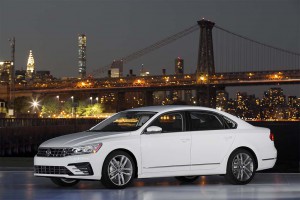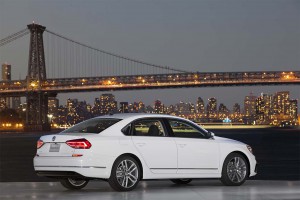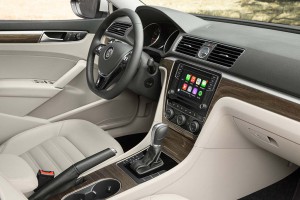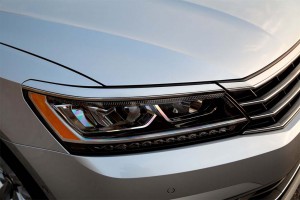
Volkswagen's 2016 Passat comes with two gas-powered engines only as the maker isn't offering the diesel model.
I’ve long been a fan of Volkswagen products. For many decades, they’ve been big on safety and reliability, and fun to drive. Think Rabbit, Golf, GTI, CC and R32. But they also offer a good value when it comes to affordable sedan performance. Think Jetta and Passat. For those who like the ability to carry families and gear, Tiguan and Touareg SUVs foot the bill.
On a recent fall day in beautiful Stowe, Vermont, Volkswagen gave members of the automotive press an opportunity to test drive the newly updated Passat. The largest passenger car model in VW’s U.S. line-up, the 2016 sedan arrives at an awkward time for the automaker, caught up in the fiasco over its cheating on diesel emissions tests.
And, notably, there’ll be no diesel version of the 2016 Volkswagen Passat, the German maker deciding it best to put that version on hold, at least for the time being. That’s a disappointment for fans of the maker’s oil-burners – which account for about a quarter of its U.S. sales.
But with two alternative powertrains in the line-up, we headed to New England to see how the new Passat shapes up against a crowded field of midsize competitors.
Among the most immediately apparent changes, the American-made Passat gets a new, domed hood and LED lighting, front and back. The headlamps are smaller, while the front and rear fenders, as well as the grille have also been revised — though the roof and doors are unchanged, as are the 2016 Passat’s overall dimensions. That, in itself, isn’t bad. The previous generation featured one of the roomiest cabins in the midsize class.
Inside, the revised VW Passat gets a new instrument panel and center stack, with a larger touchscreen display and, on the whole, a more premium feel than the outgoing sedan.
For the first time, VW will offer an R-Line version of the Passat. Among the sporty touches, it gets unique rocker panels, a “stylized” front bumper with contrasting black accents, a revised rear diffuser and 19-inch aluminum alloy wheels.
We got the opportunity to drive two different versions of the 2016 Volkswagen Passat, both in SEL trim. One was outfitted with the maker’s 1.8-liter turbocharged four, and the other the more powerful 3.6-liter six.
I drove two SEL models, one featuring the venerable 1.8 T turbocharged four, and the other the powerful 3.6-liter, narrow angle six.
Aside from a prodigious increase in power that one would expect from the 280-horsepower V6, the two SEL models are the same, featuring premium content and superb build quality. On road dynamics are similar, allowing for the slight weight increase in the VR6 car.
During our test drive ride around Stowe, the new Passat showed typical Passat agility, and an impressive level of chassis compliance. Passat features electro-mechanical speed-sensitive power steering, allowing for quick inputs on switchback roads. Low cabin noise levels enhanced the on-road experience.
I spent the most time behind the wheel of the VR6 model with VW’s DSG dual-clutch transmission. While the 1.8T provides decent acceleration, the VR6 is the hot ticket with the Passat’s well balanced road manners. No appreciable front-wheel drive torque steer was evident in either trim level.
(VW sets deadline for diesel whistleblowers. Click Here for more.)
As we’ve come to expect from all VW models, interior fit and finish is first rate. The seats are super supportive for long distance driving. Rear seat passengers can now enjoy optional seat heaters. Every switch and dial falls comfortably within reach.
Besides the elimination of the diesel, the 2016 update focuses mostly on safety upgrades, with a few new cosmetic touches thrown in for good measure.
Aside from a prodigious increase in performance that one would expect from the 280-horsepower V6, the two SEL models are the same, featuring premium content and superb build quality.
There are many viable competitors in the midsize sedan market, the Passat operates in, with prices running from $20,000 all the way up to $40,000. It’s a tough group, with players like Toyota, Honda, Nissan, Ford, Chevrolet and Hyundai all targeting mainstream buyers, but even a few luxury alternatives within reach.
What sets VW and the new Passat apart from other makes is that the car offers safety and technology features that belie its price point. I often get asked by family, friends and people I meet who find out my line of work for recommendations for new and used vehicle purchases. I always tell them to buy their vehicles based on safety.
(New studies show advanced safety features are top of mind for American car buyers. Click Here for the full story.)
How well do they hold up in a crash? What are standard and optional features that will keep you safe? How reliable is the model? What are insurance rates for the model?
Keeping these variables in mind, Volkswagens are always on my list of brands to consider, particularly for younger drivers.
For 2016, my SEL test models came standard with frontal, front-side and side-curtain airbags; antilock brakes; electronic stability control, tire pressure monitors and the Intelligent Crash Response System (ICRS). Following an airbag deployment or the activation of the safety belt ‘tensioners’ engaged by a vehicle crash sensor, the ICRS system takes several steps to ensure occupants can exit the vehicle more easily, while making the area around the vehicle safer for first responders.
First, ICRS unlocks all of the doors, saving precious seconds should occupants need to exit the vehicle, and making it easier for first responders to access the cabin of the car if required. The system also engages the vehicle’s interior lights, making it easier for occupants to locate door handles, and allowing emergency personnel to assess the situation quickly.
Next, ICRS disables the fuel pump, instantly stopping the engine and preventing the vehicle from further unwanted movement. More importantly, stopping the fuel pump ensures the fuel supply stays in the tank, reducing or eliminating the risk of a fire. ICRS also disengages all high-voltage electronics.
Visibility is key to safety in many driving situations, including immediately following an accident. Though a simple step, drivers typically forget to activate the hazard lamps after a collision, so the ICRS system does it for them. Immediately after impact, hazard lamps are enabled to make the vehicle easier to spot for emergency personnel and other motorists. This can aid rescue efforts in low-visibility situations and even prevent subsequent impacts with other vehicles.
Working in conjunction with the ICRS system are advanced airbags, which offer a perimeter of protection to all occupants. Passat’s laser-seam welded body structure forms the safety-shell, and also serves as an impact-absorbing measure in the case of a crash.
Of course, the best solution is to avoid a crash in the first place. That’s why a range of pre-emptive safety systems are installed as standard on all 2016 VW Passat models.
On the technology front, my $37,655 V6 SEL Premium featured a rearview camera, Adaptive cruise control, Front Assist with Autonomous Emergency Braking; Park Distance Control; Park Steering Assistant (self parking car!); Lane Departure Warning System; Blind Spot Monitor with rear traffic alert; keyless start, memory seats, Easy-Open trunk lid; 6.3-inch touchscreen navigation; Fender premier audio, Bluetooth, SiriusXM Satellite Radio, and more.
The new Passat is also well connected, with CAR-NET features that include: App-Connect (smartphone integration and interface), Guide & Inform (navigation and infotainment), and Security and Service (emergency services, remote vehicle diagnostics, etc. And Passat comes with a comprehensive five-year/60,000 mile powertrain warranty.
Like the outgoing model, the 2016 Passat is being assembled at VW’s plant in Chattanooga, Tennessee.
The new sedan starts at $22,440 — plus destination charges — with the 1.8-liter turbo delivering up to 38 mpg on the highway.
(For more on the 2016 VW Passat, Click Here.)
With VW sales a bit slow until its diesel mess is sorted out, it’s far from certain how consumers will engage with the brand. October sales were up, year-over-year, but lagged behind the industry overall. If anything, that might make this a particularly good time for VW fans to visit a showroom and negotiate a deal on a 2016 Volkswagen Passat.




I understand the intent of ICRS but disabling the engine via fuel pump disablement, after an airbag deployment may not be ideal as there are times when moving the car and it’s occupants out of additional harms way is critically important. It’s a no win situation where ICRS could be a liability or a life saver.